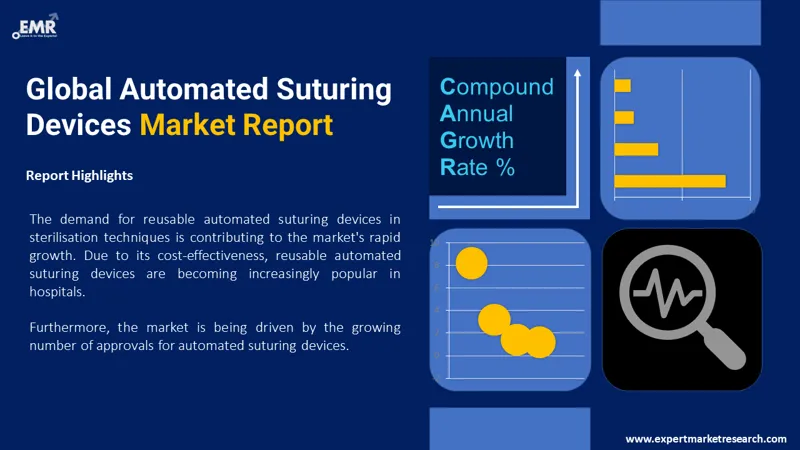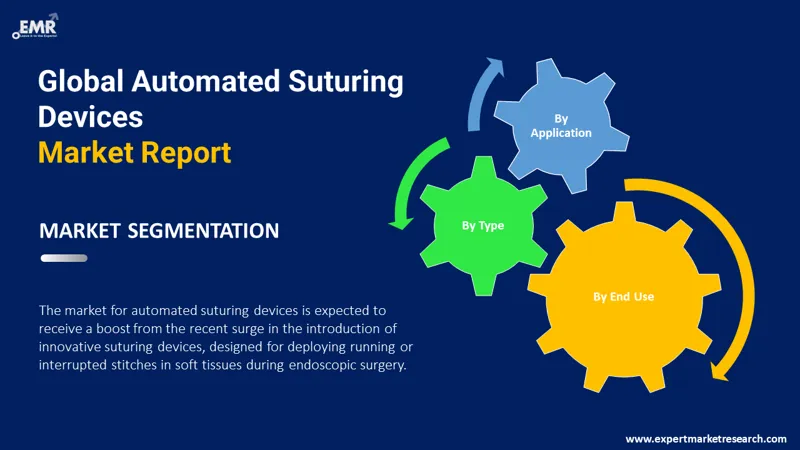
Consumer Insights
Uncover trends and behaviors shaping consumer choices today
Procurement Insights
Optimize your sourcing strategy with key market data
Industry Stats
Stay ahead with the latest trends and market analysis.
The global automated suturing devices market size reached a value of USD 1007.70 Million in 2025. The major drivers of the market are the increasing prevalence of health issues, the surging popularity of minimally invasive diseases, and the rising number of surgeries. The market is anticipated to grow at a CAGR of 6.30% during the forecast period of 2026-2035 to attain a value of USD 1856.37 Million by 2035.
Base Year
Historical Period
Forecast Period
Compound Annual Growth Rate
6.3%
Value in USD Million
2026-2035
*this image is indicative*
Cardiovascular diseases (CVDs), particularly ischemic heart disease (IHD) and stroke, are one of the leading causes of death and disability worldwide. The growth in the number of surgical procedures, the increasing prevalence of chronic diseases, and the rising geriatric population are predicted to fuel the automated suturing devices market. With the growing popularity of minimally invasive surgery (MIS), a cutting-edge method that allows surgeons to use endoscopic treatments to treat a variety of problems, the utilisation of automated suturing devices, owing to their enhanced ergonomics and speeds is increasing. Moreover, the surging demand for automated suturing devices to enhance precision in minimally invasive surgeries and reduce the risk of needle loss is propelling the market growth. With the growing focus on shortening operation time, reducing risks, enhancing cost-effectiveness, and improving clinical outcomes of minimally-invasive surgeries, the adoption of automated suturing devices is likely to grow in the coming years.

Read more about this report - REQUEST FREE SAMPLE COPY IN PDF
Automated suturing devices are devices that ease suturing procedures in both open and minimally invasive surgery. They are commonly used in trauma and surgical procedures that require surgery. These procedures are proven to result in faster wound healing, and shorter hospital stays for patients.
Breakup by Type
Breakup by Application
Breakup by End User
Breakup by Region

Read more about this report - REQUEST FREE SAMPLE COPY IN PDF
The increasing use of handheld automated suturing devices in hospitals to close wounds in tight spaces while improving recovery time and minimising hospital stay is augmenting the market growth. The automated suturing devices market is being aided by the commercialisation of new treatment options for patients. With the surging demand for reusable automated suturing devices in sterilisation techniques, the market is growing rapidly. As reusable automated suturing devices is cost-effective, it is increasingly preferred in hospitals. In addition, the surging approvals of automated suturing devices are providing impetus to the market growth.
North America accounts for a significant share in the automated suturing devices market due to the wide presence of key players, technological advancements and innovations, and the rising prevalence of occupational injuries, accidents, and surgeries. The introduction of various favourable healthcare initiatives and the robust healthcare infrastructure in the region are driving the market growth. Moreover, the surging launches of innovative suturing devices that can be deployed for the placement of running or interrupted stitches in soft tissues during endoscopic surgery are likely to bolster the market.
The report presents a detailed analysis of the following key players in the global automated suturing devices market, looking into their capacity, market shares, and latest developments like capacity expansions, plant turnarounds, and mergers and acquisitions:
The comprehensive report looks into the macro and micro aspects of the industry. The EMR report gives an in-depth insight into the market by providing a SWOT analysis as well as an analysis of Porter’s Five Forces model.




*While we strive to always give you current and accurate information, the numbers depicted on the website are indicative and may differ from the actual numbers in the main report. At Expert Market Research, we aim to bring you the latest insights and trends in the market. Using our analyses and forecasts, stakeholders can understand the market dynamics, navigate challenges, and capitalize on opportunities to make data-driven strategic decisions.*
Get in touch with us for a customized solution tailored to your unique requirements and save upto 35%!
In 2025, the global market for automated suturing devices reached a value of USD 1007.70 Million.
The market is anticipated to grow at a CAGR of 6.30% during the forecast period of 2026-2035 to reach a value of USD 1856.37 Million by 2035.
The major drivers of the market are the increasing prevalence of health issues, the surging popularity of minimally invasive diseases, and the rising number of surgeries.
The key market trends include the growing product launches of automated suturing devices, technological advancements and innovations, and the cost-effectiveness of reusable automated suturing devices.
The major regions in the market are North America, Latin America, the Middle East and Africa, Europe, and the Asia Pacific.
The various types of automated suturing devices are disposable and reusable.
The significant applications of automated suturing devices are cardiovascular, orthopaedic, gastrointestinal, ophthalmic, gynaecological, and dental, among others.
The major end uses of automated suturing devices are ambulatory surgical centres, hospitals, and clinics.
The major players in the market are Medtronic plc, Smith & Nephew plc, Apollo Endosurgery, Inc., Sutrue Limited, and Mellon Medical B.V, among others.
Explore our key highlights of the report and gain a concise overview of key findings, trends, and actionable insights that will empower your strategic decisions.
| REPORT FEATURES | DETAILS |
| Base Year | 2025 |
| Historical Period | 2019-2025 |
| Forecast Period | 2026-2035 |
| Scope of the Report |
Historical and Forecast Trends, Industry Drivers and Constraints, Historical and Forecast Market Analysis by Segment:
|
| Breakup by Type |
|
| Breakup by Application |
|
| Breakup by End User |
|
| Breakup by Region |
|
| Market Dynamics |
|
| Supplier Landscape |
|
| Companies Covered |
|
Datasheet
One User
USD 3,299
USD 2,969
tax inclusive*
Single User License
One User
USD 5,499
USD 4,949
tax inclusive*
Five User License
Five User
USD 6,999
USD 5,949
tax inclusive*
Corporate License
Unlimited Users
USD 8,199
USD 6,969
tax inclusive*
*Please note that the prices mentioned below are starting prices for each bundle type. Kindly contact our team for further details.*
Flash Bundle
Small Business Bundle
Growth Bundle
Enterprise Bundle
*Please note that the prices mentioned below are starting prices for each bundle type. Kindly contact our team for further details.*
Flash Bundle
Number of Reports: 3
20%
tax inclusive*
Small Business Bundle
Number of Reports: 5
25%
tax inclusive*
Growth Bundle
Number of Reports: 8
30%
tax inclusive*
Enterprise Bundle
Number of Reports: 10
35%
tax inclusive*
How To Order

Select License Type
Choose the right license for your needs and access rights.

Click on ‘Buy Now’
Add the report to your cart with one click and proceed to register.

Select Mode of Payment
Choose a payment option for a secure checkout. You will be redirected accordingly.
Gain insights to stay ahead and seize opportunities.

Get insights & trends for a competitive edge.

Track prices with detailed trend reports.

Analyse trade data for supply chain insights.

Leverage cost reports for smart savings

Enhance supply chain with partnerships.

Connect For More Information
Our expert team of analysts will offer full support and resolve any queries regarding the report, before and after the purchase.
Our expert team of analysts will offer full support and resolve any queries regarding the report, before and after the purchase.
We employ meticulous research methods, blending advanced analytics and expert insights to deliver accurate, actionable industry intelligence, staying ahead of competitors.
Our skilled analysts offer unparalleled competitive advantage with detailed insights on current and emerging markets, ensuring your strategic edge.
We offer an in-depth yet simplified presentation of industry insights and analysis to meet your specific requirements effectively.
Share